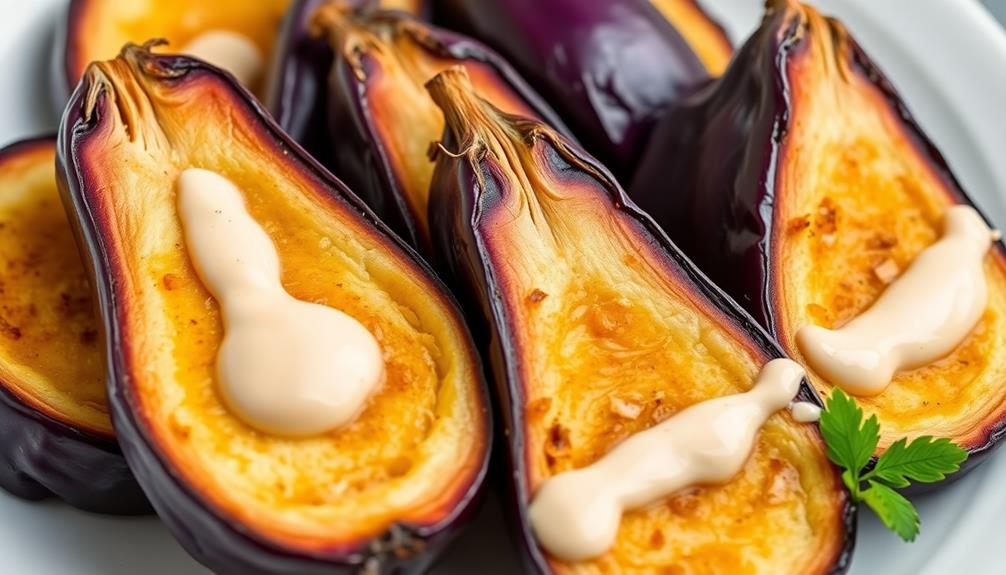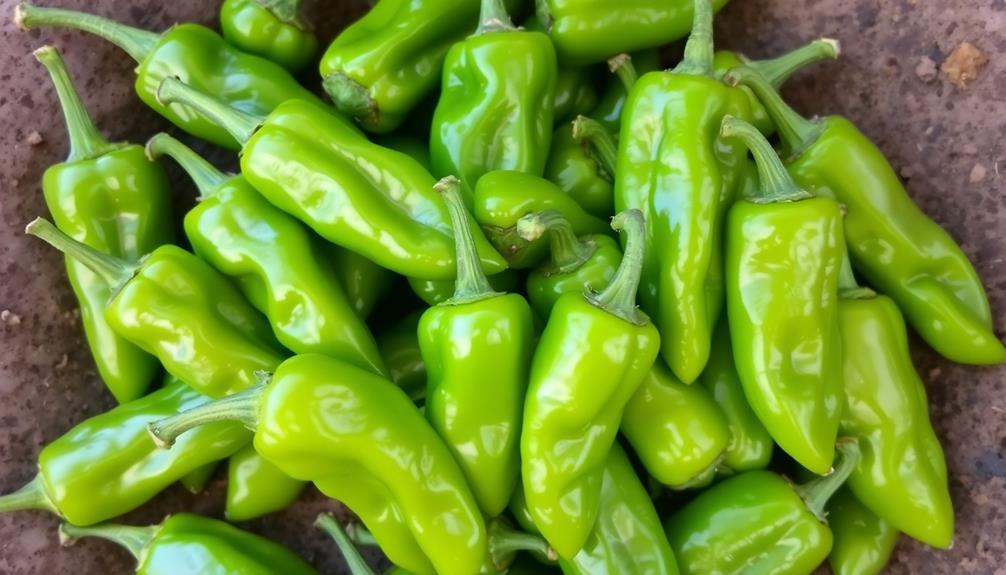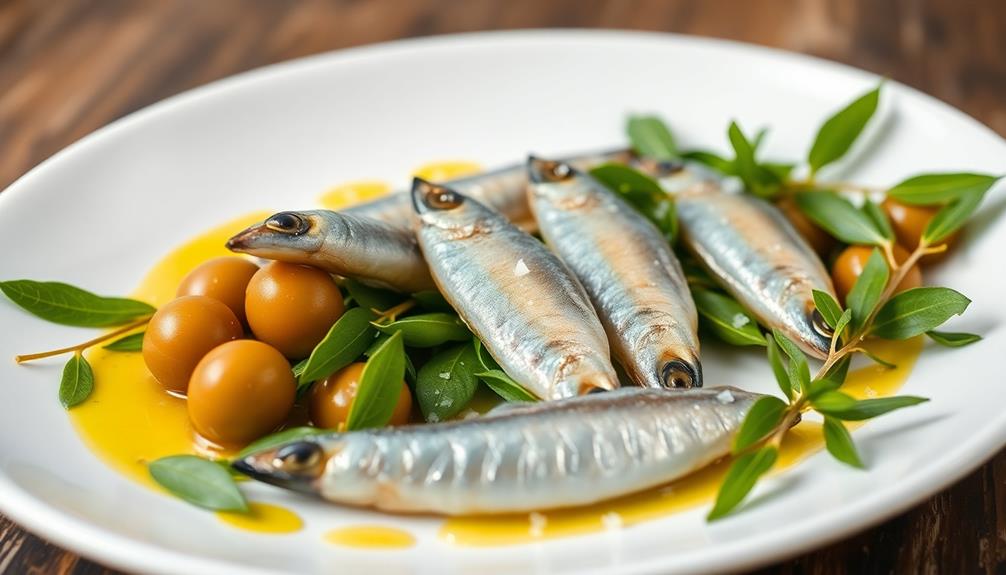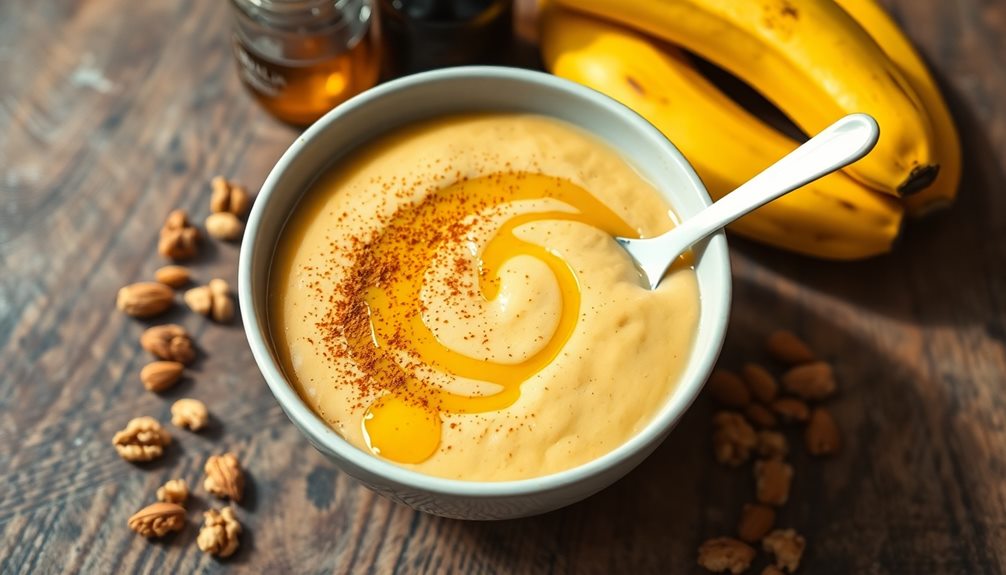Crema catalana is a beloved Spanish custard dessert hailing from the Catalonia region, blending a rich, velvety texture with a crisp caramelized sugar topping that has captivated palates for centuries. Originating in medieval monasteries, this iconic treat evolved to showcase regional flavors like citrus and cinnamon, becoming a symbol of Catalan culture and community. To make it, you gently heat eggs, milk, and sugar, then torch the surface to achieve a satisfying contrast. Crema catalana is often served chilled, making it a refreshing year-round delight. Let's dive deeper into the history and techniques behind this delectable dessert.
Key Takeaways
- Crema Catalana is a classic Spanish dessert originating in the 14th century Catalonia, with a custard-based filling and a caramelized sugar topping.
- It is a cultural symbol for the Catalan people, commonly served at family gatherings and festive events, representing hospitality and sharing.
- The dessert is known for its rich, velvety texture and the contrast between the creamy custard and the crisp caramelized crust.
- The recipe involves gently heating egg yolks, milk, and sugar to create a silky-smooth custard, which is then topped with caramelized sugar.
- Crema Catalana is often compared to the French crème brûlée, but with distinct regional flavors such as citrus zest and cinnamon.
History
The origins of Crema Catalana can be traced back to the 14th century, when Spanish and Catalan culinary traditions began to converge. This decadent custard dessert has its roots in the medieval monasteries of Catalonia, where monks would experiment with simple ingredients like eggs, cream, and sugar.
Over time, the recipe evolved, incorporating the unique flavors of the region – like the zest of citrus fruits and the warmth of cinnamon. By the 17th century, Crema Catalana had become a beloved staple, gracing the tables of aristocrats and commoners alike.
Today, this iconic dish remains a source of pride for the Catalan people, symbolizing their rich cultural heritage.
Whether enjoyed in a cozy cafe or at a lively festival, Crema Catalana continues to delight and inspire, a timeless testament to the enduring power of culinary tradition.
Recipe
Crema Catalana is a classic Spanish dessert that originates from the Catalonia region. It's a custard-based dish with a caramelized sugar topping, similar to crème brûlée. This delightful treat is renowned for its rich, velvety texture and the satisfying contrast between the creamy custard and the crisp caramelized sugar crust. If you ever have the opportunity to visit Catalonia, be sure to indulge in a serving of Crema Catalana. It’s often enjoyed as a dessert after a delicious meal of traditional Spanish cuisine, such as paella, tapas, or a tasty croquettes recipe. The combination of flavors and textures in Crema Catalana makes it a perfect ending to any dining experience.
The preparation of Crema Catalana is a delicate process that requires patience and attention to detail. The custard base is made by gently heating a mixture of eggs, milk, and sugar, resulting in a luscious and silky-smooth consistency. The final touch is the caramelized sugar topping, which is achieved by carefully broiling or using a kitchen torch to create a crisp, golden-brown crust.
Ingredients:
- 4 large egg yolks
- 1/2 cup (100g) granulated sugar
- 2 cups (500ml) whole milk
- 1 vanilla bean, split lengthwise
- 2 tablespoons cornstarch
- Zest of 1 lemon
- 2 tablespoons granulated sugar for caramelizing
Instructions:
In a medium saucepan, whisk together the egg yolks and 1/2 cup of sugar until pale and creamy. Gradually stir in the milk and vanilla bean.
Cook over medium heat, stirring constantly, until the mixture thickens and coats the back of a spoon, about 10-15 minutes. Remove the vanilla bean. Whisk in the cornstarch and lemon zest until well combined.
Pour the custard into ramekins or a shallow baking dish and refrigerate for at least 2 hours or up to 3 days.
When ready to serve, sprinkle the tops of the chilled custards evenly with the remaining 2 tablespoons of sugar. Using a kitchen torch, caramelize the sugar topping until it's golden and crisp.
Alternatively, you can place the ramekins under a preheated broiler for 1-2 minutes, watching carefully, until the sugar is caramelized. Serve the Crema Catalana immediately, while the sugar topping is still warm and crunchy.
Cooking Steps
First, heat the milk and cream in a saucepan until simmering.
Next, whisk the egg yolks and sugar in a separate bowl until the mixture is thick and pale.
Carefully pour the egg yolk mixture into the hot milk, stirring continuously, then pour the custard into individual ramekins.
Step 1. Heat Milk and Cream
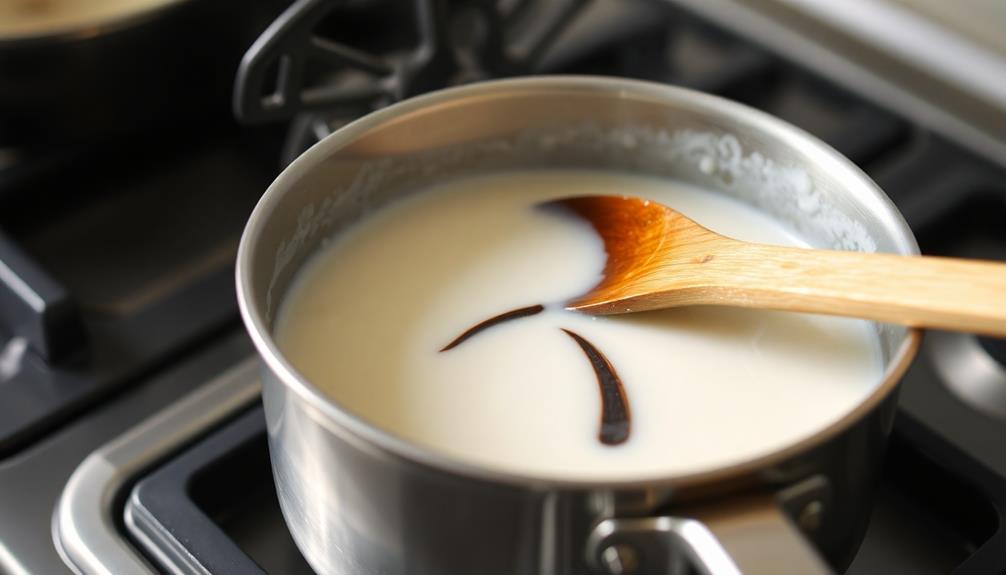
Next, you'll need to combine the milk and cream in a saucepan, heating the mixture over medium heat.
Slowly bring the liquids to a gentle simmer, stirring occasionally to prevent scorching. You'll want to keep a close eye on the pan, as you don't want the mixture to boil over.
Once the milk and cream are steaming and small bubbles start to form around the edges, remove the saucepan from the heat.
Let the mixture cool slightly, then carefully pour it into a clean bowl. Cover the bowl with plastic wrap, pressing it directly onto the surface of the liquid to prevent a skin from forming.
Refrigerate the mixture for at least 30 minutes, or until it's completely chilled.
This step helps to develop the rich, velvety texture that defines the classic Crema Catalana.
Step 2. Whisk Egg Yolks and Sugar
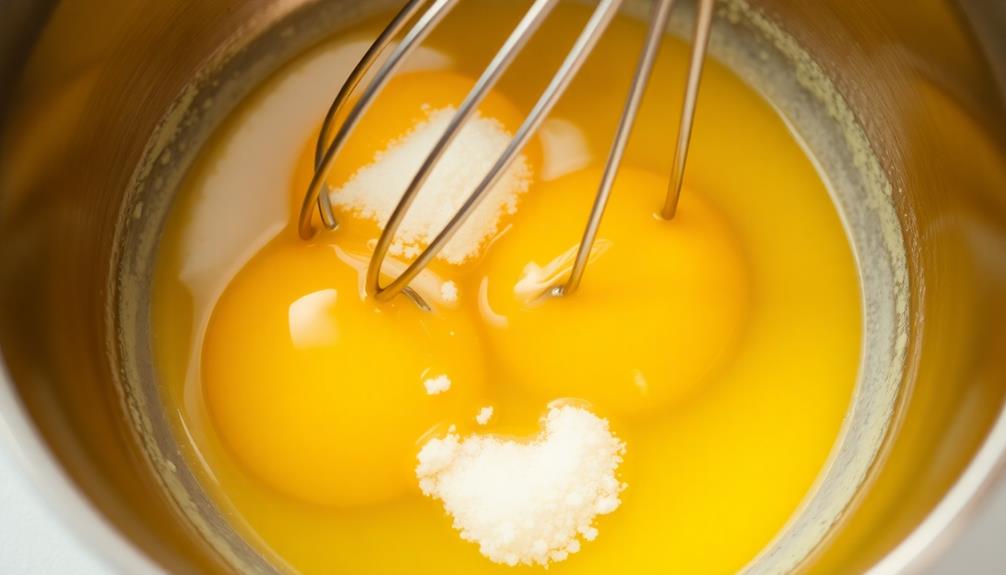
After the dairy mixture has properly chilled, you'll want to whisk together the egg yolks and sugar.
In a medium-sized bowl, crack open the egg yolks and discard the whites. Add the granulated sugar and use a whisk to blend the two ingredients until they're light and fluffy. This process helps to create a rich, custard-like texture for the final Crema Catalana.
Be sure to whisk vigorously, incorporating air into the mixture. The yolks and sugar should become pale yellow and thickened.
This step is crucial, as it sets the stage for the smooth, creamy consistency of the dessert. Once the yolks and sugar are fully incorporated, set the bowl aside.
You're now ready to temper the egg mixture and complete the Crema Catalana.
Step 3. Carefully Mix Egg Yolk Mixture
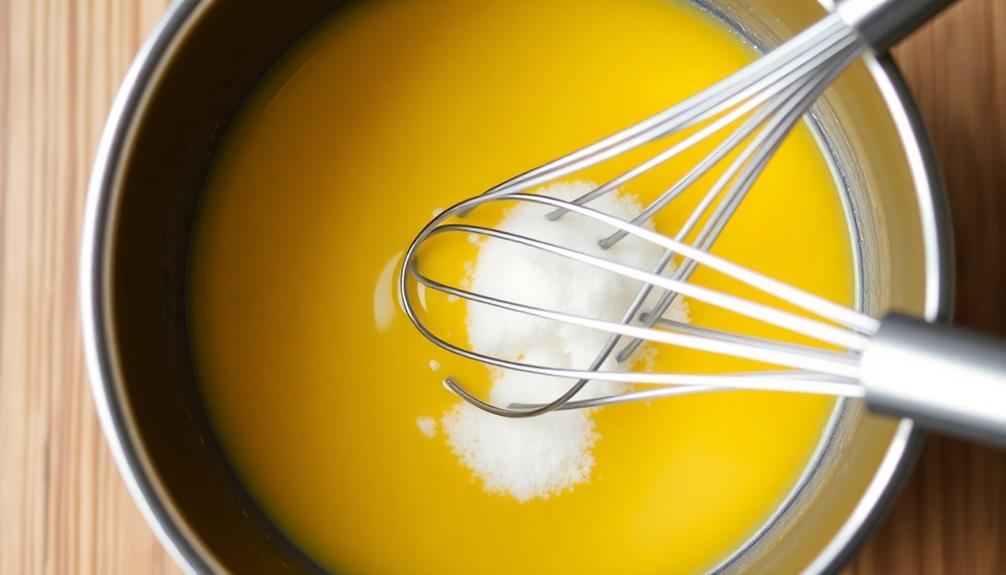
With the egg yolk and sugar mixture ready, you can now carefully incorporate it into the chilled dairy mixture.
Grab a whisk and gently stir the two components together, taking care not to overmix. The goal is to create a smooth, homogeneous blend without incorporating too much air.
As you whisk, pour the egg yolk mixture in a slow, steady stream, allowing it to fully incorporate before adding more. Be patient and take your time – the key is to avoid scrambling the eggs or creating a grainy texture.
Once the mixture is thoroughly combined, you can move on to the final step.
Carefully pour the custard into your prepared ramekins or baking dish. Make sure to distribute it evenly, then refrigerate the dish for at least 2 hours, or until the crema catalana has set completely.
This chilling process is essential for achieving the desired creamy, silky texture.
Step 4. Pour Mixture Into Ramekins

Carefully pour the custard into the prepared ramekins or baking dish, distributing it evenly. Make sure to leave a bit of space at the top of each ramekin, as the mixture will puff up during the baking process.
Use a ladle or measuring cup to scoop and pour the custard, ensuring an equal amount in each vessel. Smooth the surface with the back of a spoon, if needed, creating a smooth and even top.
Once all the ramekins are filled, place them on a rimmed baking sheet. This will make it easier to transfer the ramekins in and out of the oven.
Preheat your oven to the specified temperature, then carefully slide the baking sheet with the filled ramekins onto the middle rack. Bake the crema catalana until the centers are just set, but still slightly jiggly, about 20-25 minutes. Keep a close eye to prevent overbaking.
Step 5. Caramelize Sugar With Kitchen Torch

Once the crema catalana has finished baking and the centers are just set, it's time to caramelize the sugar using a kitchen torch. This step adds a delightful crunch and golden hue to the top of your dessert.
Carefully hold the kitchen torch approximately 6 inches above the surface of the ramekins. Slowly move the flame back and forth, keeping it moving to ensure even caramelization. Watch closely as the sugar begins to bubble and turn a golden brown.
Be patient and take your time, as this process can take a minute or two. Once the sugar has reached your desired level of caramelization, extinguish the torch.
Allow the desserts to cool for a few minutes before serving. The caramelized sugar will harden into a delightful crisp topping, complementing the smooth, creamy custard underneath. This final touch transforms the crema catalana into a truly impressive and indulgent Spanish dessert.
Final Thoughts
What final thoughts do you have about this captivating crema catalana recipe?
You've mastered the art of caramelizing sugar with a kitchen torch, creating that irresistible crackly shell.
Now, as you savor the last silky spoonful, you can't help but appreciate the balance of flavors and textures in this classic Spanish dessert.
The rich, creamy custard base is the perfect canvas for the sweet, caramelized topping.
This recipe has transported you to the bustling streets of Barcelona, where you can almost hear the laughter of friends and family gathered around the table.
As you tidy up the kitchen, you make a mental note to add this crowd-pleasing dessert to your repertoire.
The next time you host a special occasion, crema catalana will undoubtedly be the star of the show, impressing your guests with its sophisticated yet approachable charm.
Frequently Asked Questions
What Is the Difference Between Crema Catalana and Crème Brûlée?
Though crème brûlée and crema catalana may seem similar, there's a key difference. Crème brûlée features a rich, creamy custard topped with a crisp, caramelized shell, while crema catalana has a silkier texture and a distinctive cinnamon flavor.
How Long Does Crema Catalana Last Before It Goes Bad?
Crema catalana typically lasts about 3-4 days when refrigerated in an airtight container. However, its freshness can be affected by various factors, so it's best to enjoy it within a few days of making it for optimal flavor and texture.
Can Crema Catalana Be Served Warm or Does It Have to Be Chilled?
You can serve crema catalana either warm or chilled, depending on your preference. It's a versatile dessert that can be enjoyed at different temperatures to suit your tastes.
Is Crema Catalana a Common Dessert in Other Parts of Spain?
Yes, crema catalana is a common dessert throughout Spain, not just in its region of origin. While the preparation may vary slightly, this creamy custard-like treat is a beloved staple on menus across the country.
Can I Make Crema Catalana Without Using a Torch?
You can indeed make crema catalana without using a torch. Simply bake the custard in the oven until it's set and then broil the top to create the caramelized crust. It may not have the same dramatic flair, but it'll still be delicious.

